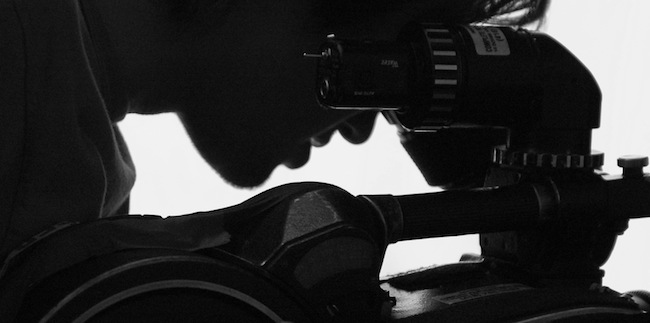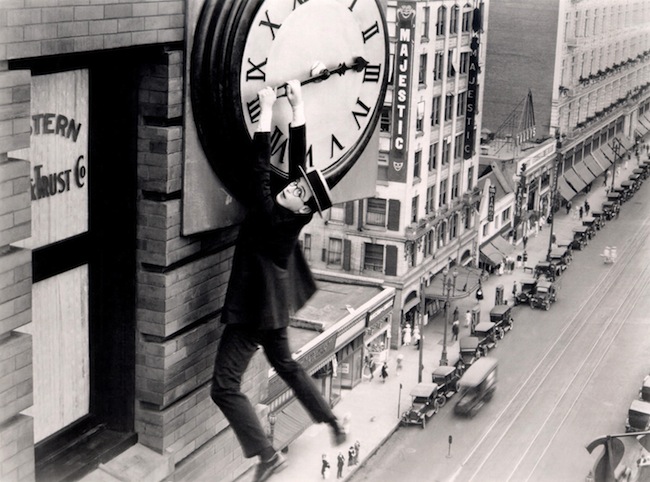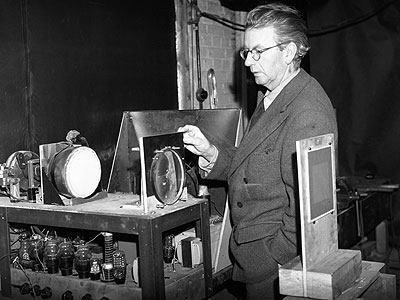Cinematography
Cinematography describes the process by which a film strip is exposed to light to create an image. It encompasses many factors: the camera’s distance from the action, camera angle and direction, type of lens, camera movement, and lighting, among others. The art of cinematography also includes mise-en-scène—the arrangement of objects and movements in the frame.
Shot Types
The amount of visual information included in the image depends on the distance of the camera from the action and on the focal lengthof the camera lens. Throughout the history of cinema, filmmakers have favored certain combinations of camera distance and focal length, or shot types.
- Extreme long shot: Captures a scene in its entirety; used for establishing location in exterior shots. Used frequently in epic genres such as westerns and war films, it reduces human beings to mere dots on the screen.
- Long shot: Accommodates at least the entire bodies of figures (if that is all the shot includes, it is called a full shot). Captures movement, background, and broad gestures and expressions.
- Medium shot: Contains a figure from the waist or knees up. It is a functional shot, favored in classical Hollywood editing, often used for scenes with dialogue.
- Close-up: Includes very little if any background, concentrating on an object or, if an extreme close-up, a fragment of an object, such as the human face. Close-ups often accord great significance and symbolic value to the objects they portray.
- Deep focus shot: A variation of the long shot that keeps objects in the foreground, middle ground, and background in focus all at once. Realist filmmakers favor it because it preserves spatial unity and lets the viewer scan the image for meaning.
- Shot-reverse shot and over-the-shoulder: Two types of shots used during dialogue scenes to give the sense that two or more characters are conversing with each other.
- Point-of-view shot: A shot framed in a way that prompts viewers to believe they are looking from a specific character’s point of view. These shots can often contribute to the process of audienceidentification with one or more characters in a film.
Camera Lenses
The camera lens is a curved piece of glass that refracts the light it receives onto a strip of film that records the visual information, creating the film image.
- Normal lens: Creates a minimum of distortion, approximating the way that objects are perceived by the human eye.
- Telephoto lens: Used to capture crowd scenes or when the camera operator wants to remain far away from the action. A telephoto lens collapses distances between foreground and background, dampening the effect of movement within the frame. It also keeps background elements out of focus, which allows a single element to be emphasized and isolated.
- Wide-angle lens: Captures a wider field of vision than a normal lens. Deep-focus shots use wide-angle lenses, exaggerating movement and shapes (especially in close-up). Lines and shapes are distorted at the edges of the frame.
Camera Angles
The direction in which the camera is pointed in relation to the action being recorded is called the camera angle.
- Bird’s-eye view: Camera is positioned high above the action, looking down on figures, who seem powerless or vulnerable.
- High: Camera is positioned above eye level, reducing the size of figures and suggesting stasis and weakness.
- Eye level: Camera is positioned at eye level, a neutral vantage point that does not impose meaning on the action.
- Low: Camera is positioned below eye level, increasing size of figures and rendering them powerful, even threatening or heroic.
- Canted: Camera is tilted to one side, creating a diagonal composition that suggests tension or impending movement.
Camera Movement
The camera can remain motionless or may be moved, rotated, or zoomed. Camera movement involves physical movement of the camera from one location to another. Camera rotation keeps the location of the camera the same but shifts the direction in which the camera is pointed. Zooming involves the adjustment of the camera’s focal length so that more or less visual information is included in the film image.
- Pan: Side-to-side rotation of the camera, often used to follow the movement of figures and keep them within the frame.
- Tilt: Top-down rotation of the camera, often used to view an object that extends above or below the frame.
- Tracking: Movement of the camera in any direction, often used to follow the movement of figures and retain their positions and proportions within the frame.
- Crane: Movement of the camera above ground level, often involving a vertical rise or drop, used to reveal elements at different heights. Variations of this shot position the camera on an airplane or helicopter.
- Shaking: Use of a handheld camera to express a psychological state or to generate a documentary-like aesthetic, as opposed to usual placement of a camera on a tripod to prevent shaking.
- Zooming: Adjustment of the camera’s focal length. A filmmaker who wants to emphasize a portion of the image can zoom in, which increases that portion’s relative size within the frame and signals to the viewer that whatever it contains is of significance. A filmmaker wants to expose the environment around a figure or action can zoom out, revealing the larger context.
- Rack focus: Adjustment of focus within a shot in order to change the portion of the image that is in sharp focus. Rack focus guides the spectator’s attention from one area of the screen to another or from one object to another. It is possible because in most shots (that do not use deep focus), only certain portions of the image are in sharp focus.
Lighting
Most interior scenes are naturally too dark to generate a clear, discernible film image, requiring the use of artificial lighting. The intensity, position, and direction of lights in relation to the action have significant effect on the look and mood of a shot.
- Lighting intensity: Intense lighting, or hard lighting, creates stark shadows and lines of contrast; soft lighting creates a diffuse illumination.
- Natural vs. artificial lighting: Realist directors often avoid the use of artificial lights and choose instead to rely on natural light that more closely approximates reality.
- Lighting setups: The principal light illuminating the scene is called the key light. A fill light is often used to cover the shadows created by the key light. Typically, a three-point lighting setup is used in order to light a scene evenly.
- Lighting effects: A high-key lighting scheme minimizes the contrast between darker and brighter parts of the image. A low-key lighting scheme creates a chiaroscuro effect, with dark shadows and stark contrasts.
- Lighting direction creates an array of effects by manipulating the size and directions of shadows.
- Frontal lighting eliminates shadows.
- Side lighting accentuates features (of the face, for instance).
- Backlighting creates silhouettes.
- Top lighting creates a benevolent “halo” effect.
- Underlighting makes a figure look sinister or even horrific.
Mise-en-Scène
Mise-en-scène is the arrangement of objects and movements within the frame—the rectangular border of the film image. Although analysis of mise-en-scène involves close inspection of the film image, keep in mind that film images are always open to a variety of different interpretations. The meanings and effects of film images are a function of the broader contexts within which they operate: those of narrative, representation, genre, history, and culture.
Blocking refers to the arrangement and movement of actors on the film set.
- Filmmakers often use blocking to express the psychological and social relationships between characters.
- For example, a shot of two characters in which each shares an equal proportion of the frame, at equal heights and depths suggests a balanced relationship in which neither of the characters has power or advantage over the other.
Framing refers to the placement of people and objects within the rectangular frame of the film image. Typically, the center of the film image contains the most important visual information. Filmmakers who want to make framing as unobtrusive as possible use centered compositions.
- The top of the film image carries more intrinsic weight, so balanced compositions usually keep the horizon line above the middle of the frame. A low horizon line can lead to a top-heavy composition, emphasizing the threatening or oppressive nature of the sky or of figures situated in the top part of the image.
- The edges of the image carry less intrinsic weight optically, so figures placed there can seem insignificant or marginalized.
- Open framing refers to compositions that situate the action depicted in the film within a broader context, suggesting that there is an “outside” to the “inside” of the film narrative.
- Closed framing is used when the filmmaker wants the film image to express the totality of reality, to keep the viewer focused on the action of the film, or to express claustrophobia and entrapment, such as in prison films.
- Framing that creates diagonal lines of composition emphasizes a scene’s anarchic, unsettled, or dynamic nature. Horizontal andvertical lines suggest order, balance, or stability.
Offscreen space is the area outside the confines of the frame.
- Offscreen space often is a crucial component of visual composition, with characters pointing to, moving toward, or looking at something that is outside the frame.
- Filmmakers can use offscreen space to create mystery or to encourage viewers to use their imagination.
Sound and Editing
Sound
Sound design in film involves the arrangement of live sound(primarily the voices of actors), sound effects, and music.
- Sound effects and live sound usually are synchronized with images to achieve a realistic representation of the action.
- Sound effects can also be used to direct the viewer’s attention offscreen or trigger camera or character movement.
- When sound and image do not match, the sound is calledcontrapuntal or asynchronous.
- Music establishes genre conventions (such as the eerie music in horror films) and has emotional effects on the viewer. It also contributes to the rhythm of narrative and can be used repeatedly to establish motifs.
- Perspective sound regulates sound volume to make it seem as if the sound originates at a certain distance from the camera.
- Dialogue overlaps and sound bridges are used to minimize the disruption caused by visual transitions at the shot level and the scene level, respectively.
Editing
A contiguous scene or segment of a scene shot on film is called atake. The process by which portions of different takes are connected together to organize the film into its final form is called editing. The connections between takes are called cuts.
- A typical Hollywood film contains over 1,000 cuts—a number that has increased steadily over time.
- Realist or art films often contain fewer cuts, such as in Theo Angelopoulos’s Thiassos (only 80 cuts in nearly four hours).
Optical effects: The editor can use a number of optical effects to connect different shots together.
- A fade-in gradually lightens the beginning of a shot from black; afade-out gradually darkens the end of a shot to black.
- In a wipe, the initial shot is replaced by the subsequent shot through a horizontal motion, as when one piece of paper is gradually slid over another.
- In a dissolve, the subsequent shot is briefly superimposed over the initial shot. Dissolves often denote the passage of time.
Continuity: The dominant style of editing in Western narrative film is called continuity editing. Continuity editing, which tries to keep the aesthetic qualities of images before and after a cut the same, is designed to minimize the distraction and disorientation caused by cuts and to establish narrative causality.
- Continuity editing follows the 180° rule, the practice of keeping the camera on one side of the action to retain consistent spatial relations between figures from shot to shot.
- Editors commonly use establishing shots to familiarize audiences with a given space and matches on action to present movement from multiple angles.
Spatiotemporal effects: Whereas continuity editing seeks to present events in chronological order and show events only once, editors often deviate from these norms.
- Flashforwards and flashbacks present events out of sequence or show events more than once (such as a persistent memory or nightmare).
- Crosscutting enables editors to show events at two of more locations simultaneously by cutting back and forth between them. This technique disrupts spatial continuity but establishes temporal simultaneity.
- Often, a film presents an event in a shorter amount of time than its actual duration. This effect is achieved by letting a character move out of frame and then, after a cut, showing the character move into frame at a new location. This effect may also be accomplished through the use of fades and cutaways.
Other editing techniques: With continuity editing, the primary site of meaning is the scene. By contrast, a montage sequence, such as the newsreel passage in Orson Welles’s Citizen Kane, uses rapid juxtaposition of images to create meaning at the shot level. Experimental filmmakers often break the rules of continuity editing, such as through the use of unexpected jump cuts to disorient the audience and undermine the realism of their representation.
The majority of commercial films have a narrative—a series of events that make up a story. While most people use the terms story and plotinterchangeably, in film studies these two terms have different meanings.
Story and Plot
The plot of a film consists of all the events and characters that are represented directly during the course of the film; the story is a broader set of events and characters, some of which are contained within the plot and others that are alluded to but not shown in the film.
- For instance, a detective film often begins at the scene of a crime. The criminal act is not shown in the film, so it is not part of the plot but is part of the story.
- Elements of a film that take place within the world of the film’s story are called diegetic. Elements of the film that exist outside of that world (such as music heard by the audience but not the characters in the film) are called extradiegetic or nondiegetic.
Narrative Development
Film narrative usually is linear and driven by cause-and-effect relationships among characters and events.
- To stimulate interest in the narrative, films typically present characters with whom viewers can identify. The characters are assigned certain traits and motivations that propel the events of the film to their conclusion.
- Although most films are character-driven, other forces can affect the course of the narrative, such as the natural world, societal structures, and historical events.
- The beginning of a film often establishes a conflict that is thenresolved, after a turning point and a climax at the conclusion of the narrative.
- Films that follow this normative pattern of conflict resolution (common in Hollywood films) are said to have a closed ending.
- A film with an open ending never fully resolves the conflicts it initiates.
Narration
Narration is the process by which the film reveals relevant information to the viewer.
- Since in most cases the audience initially knows nothing about the world of the film, early scenes typically involve exposition, wherein a large amount of information about characters and events is provided.
- If a film reveals all the relevant information required to understand the story, and the audience knows more than the characters in the film do, the film is using omniscient narration.
- If a film allows the audience to know only as much as, or less than, the characters in the film do, the film is using subjective narration.
- Films sometimes employ a narrator, whose voice can be heard on the soundtrack in the form of a voice-over, to deliver critical information to the audience.
Narrative Meaning
Films are not self-enclosed entities but make statements about the world in which we live. Films create meaning through the use ofsymbols, metaphors, and motifs, which are repeated techniques, objects, or thematic ideas.
- In allegorical films, plot events take on meanings that are greater than their function within the logic of the narrative. Sam Peckinpah’sThe Wild Bunch, for example, can be interpreted as an allegory of American militarism in Vietnam.
- Contemporary film narratives are often highly intertextual, referring to previous cultural works, whether in the cinema, television, or the other arts.
- Films depend on a willing suspension of disbelief that allows audiences to believe temporarily in the events and characters of the films’ fictional narratives.
- Filmmakers who want audiences to take a more critical position usealienation effects to remind viewers of the constructedness and unreality of their narratives.
Credits: Sparknotes





![The Man With The Flower in His Mouth – the world’s first television play [video]](https://gaukantiques.com/wp-content/uploads/2013/03/pirandello.jpg)





